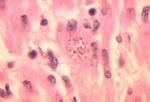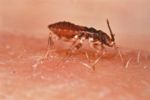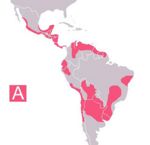Difference between revisions of "Trypanosoma"
| Line 20: | Line 20: | ||
[[Image:Triatoma infestans.jpg|thumb|right|150px|''Triatoma infestans'' the Kissing bug - WHO Wikimedia Commons]] | [[Image:Triatoma infestans.jpg|thumb|right|150px|''Triatoma infestans'' the Kissing bug - WHO Wikimedia Commons]] | ||
[[Image:Chagas endemic zones 2005.jpg|thumb|right|150px|Chagas endemic zones 2005 - Wikimedia Commons]] | [[Image:Chagas endemic zones 2005.jpg|thumb|right|150px|Chagas endemic zones 2005 - Wikimedia Commons]] | ||
| − | |||
| − | + | ==Introduction== | |
| + | Trypanosomes are '''elongated unicellular [[Protozoa | protozoal]]''' organisms with an undulating membrane and anterior flagellum. | ||
| + | ==Lifecycle== | ||
| + | The trypanosomes are transmitted by '''haematophagous insect''' vectors including the '''[[Glossinidae | tsetse fly]]''' and '''triatomid''' kissing bug. | ||
| + | ===Stercorarian=== | ||
| + | Stercorarian trypanosomes develop in the '''posterior gut''' of the insect and infective '''metatrypanosomes''' are excreted in the '''faeces''' of the insect onto the '''skin''' of the host. | ||
| − | + | They can then '''penetrate''' the tissues. The metatrypanosomes then multiply within the reticulo-endothelial system of the host, later '''disseminating''' throughout the organs. | |
| − | + | '''Trypomastigotes''' then enter the bloodstream and can reinvade new tissues as anastigotes as well as infecting insects during bloodfeeding. | |
| − | |||
| − | |||
| − | + | '''''T. cruzi''''', the trypanosome of '''most veterinary importance''', is a typical Stercorarian trypanosome and utilises the '''triatomid “kissing bug”''' as its vector. | |
| − | |||
| − | |||
| − | |||
| − | |||
| − | |||
| − | |||
| − | |||
| − | |||
| − | |||
| − | |||
| − | + | ''T. theileri'' is transmitted by [[Tabanidae | tabanid flies]], [[Stomoxys calcitrans | stable flies]], [[Ticks | ticks]] and [[Culicidae | mosquitoes]] | |
| − | + | ===Salivarian=== | |
| + | Salivarian trypanosomes develop in the '''anterior gut''' of their vector, the '''[[Glossinidae | Tsetse fly]]'''. | ||
| − | + | Development occurs in the '''proboscis''' and midgut, forming '''epimastigotes''' which then invade the '''hypopharynx''' and develop into '''trypomastigotes''' and then '''infective metatrypanosomes''' form. | |
| − | + | These are then innoculated into the mammalian host through a '''bite''' before a blood meal. | |
| − | |||
| − | |||
| − | ''' | + | ==Pathogenesis== |
| − | + | Trypanosomes '''deplete''' carbohydrates, proteins, lipids and micronutrients from their hosts. | |
| − | + | They cause '''haemolytic [[Anaemia | anaemia]]''' when present within the bloodstream. | |
| + | ==Diseases== | ||
| + | [[Trypanosomosis]] affects the lymphoid and haeatopoeitic systems of a wide range of hosts. | ||
| + | ===Salivarian Species=== | ||
| + | ''T. brucei'' affects '''all domestic mammals''', including small and farm species, and humans. It also causes a specific [[Protozoal Skin Infections - Donkey|skin disease in donkeys]]. | ||
| − | + | ''T. vivax'' infects ruminants, horses and camels causing significant disease. | |
| − | |||
| − | + | ''T. equiperdum'' causes '''venereal''' equine disease '''dourine'''. It is the only trypanosome that does not immediately require an insect vector for transmission, being spread through coitus. | |
| − | ''' | + | ''T. simiae'' causes fatal pyrexia in '''pigs''' while ''T. congolense'' is milder in the same species. |
| − | + | ||
| + | ''T. congolense'' can also affect '''dogs and cats''' causing acute fever, anaemia and neurological signs. | ||
| − | + | ''T. evansi'' also affects all domestic mammals. | |
| − | |||
| − | + | ===Stercorarian Species=== | |
| − | + | '''''T. cruzi''''' occurs in '''South America''' where it is transmitted by a triatomid (kissing) bug and infects armadillos, possums and humans. It is known as '''''Chagas’ Disease'''''. | |
| − | + | A similar acute disease is thought to be caused by ''T. cruzi'' in dogs in the USA. | |
| − | + | ''T. melophagum'' and ''T. Theileri'' are '''non-pathogenic''' species present in the '''UK''' infecting cattle, buffalo and antelope. Stress and concurrent disease are thought to be contributors to the development of clinical disease from ''T. theileri''. | |
| − | |||
| − | |||
| + | ==References== | ||
| + | <references/> | ||
| + | Animal Health & Production Compendium, '''Trypanosoma datasheet''', accessed 06/06/2011 @ http://www.cabi.org/ahpc/ | ||
| + | Animal Health & Production Compendium, '''Trypanosomiasis datasheet''', accessed 06/06/2011 @ http://www.cabi.org/ahpc/ | ||
==Test yourself with the Protozoa Flashcards== | ==Test yourself with the Protozoa Flashcards== | ||
| Line 82: | Line 78: | ||
[[Category:Tropical Protozoa]] | [[Category:Tropical Protozoa]] | ||
| − | [[Category:To_Do_- | + | [[Category:To_Do_-_CABI review]] |
Revision as of 11:45, 6 June 2011
|
| Trypanosoma sp | |
|---|---|
| Kingdom | Protista |
| Phylum | Protozoa |
| Order | Kinetoplastida |
| Family | Trypanosomatidae |
| Genus | Trypanosoma |
Introduction
Trypanosomes are elongated unicellular protozoal organisms with an undulating membrane and anterior flagellum.
Lifecycle
The trypanosomes are transmitted by haematophagous insect vectors including the tsetse fly and triatomid kissing bug.
Stercorarian
Stercorarian trypanosomes develop in the posterior gut of the insect and infective metatrypanosomes are excreted in the faeces of the insect onto the skin of the host.
They can then penetrate the tissues. The metatrypanosomes then multiply within the reticulo-endothelial system of the host, later disseminating throughout the organs.
Trypomastigotes then enter the bloodstream and can reinvade new tissues as anastigotes as well as infecting insects during bloodfeeding.
T. cruzi, the trypanosome of most veterinary importance, is a typical Stercorarian trypanosome and utilises the triatomid “kissing bug” as its vector.
T. theileri is transmitted by tabanid flies, stable flies, ticks and mosquitoes
Salivarian
Salivarian trypanosomes develop in the anterior gut of their vector, the Tsetse fly.
Development occurs in the proboscis and midgut, forming epimastigotes which then invade the hypopharynx and develop into trypomastigotes and then infective metatrypanosomes form. These are then innoculated into the mammalian host through a bite before a blood meal.
Pathogenesis
Trypanosomes deplete carbohydrates, proteins, lipids and micronutrients from their hosts.
They cause haemolytic anaemia when present within the bloodstream.
Diseases
Trypanosomosis affects the lymphoid and haeatopoeitic systems of a wide range of hosts.
Salivarian Species
T. brucei affects all domestic mammals, including small and farm species, and humans. It also causes a specific skin disease in donkeys.
T. vivax infects ruminants, horses and camels causing significant disease.
T. equiperdum causes venereal equine disease dourine. It is the only trypanosome that does not immediately require an insect vector for transmission, being spread through coitus.
T. simiae causes fatal pyrexia in pigs while T. congolense is milder in the same species.
T. congolense can also affect dogs and cats causing acute fever, anaemia and neurological signs.
T. evansi also affects all domestic mammals.
Stercorarian Species
T. cruzi occurs in South America where it is transmitted by a triatomid (kissing) bug and infects armadillos, possums and humans. It is known as Chagas’ Disease. A similar acute disease is thought to be caused by T. cruzi in dogs in the USA.
T. melophagum and T. Theileri are non-pathogenic species present in the UK infecting cattle, buffalo and antelope. Stress and concurrent disease are thought to be contributors to the development of clinical disease from T. theileri.
References
Animal Health & Production Compendium, Trypanosoma datasheet, accessed 06/06/2011 @ http://www.cabi.org/ahpc/
Animal Health & Production Compendium, Trypanosomiasis datasheet, accessed 06/06/2011 @ http://www.cabi.org/ahpc/



